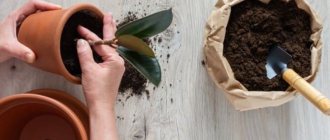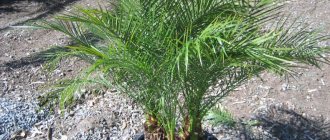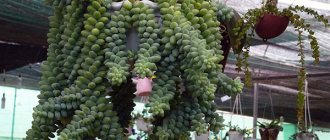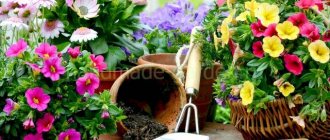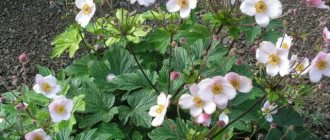Severe soil depletion
A critical decrease in the level of nutrients in the soil can cause the death of flowers. When growing flowers on a windowsill, you need to take into account that their root system is severely limited by the volume of the container; it cannot grow to obtain the necessary minerals.
The soil in pots where fast-growing species were planted, capable of rapidly increasing green mass, is depleted especially quickly. Also, the soil is deprived of nutrients if fertilizing is not carried out. In this case, it is urgent to transplant the plant into a larger container filled with fresh substrate.
How to understand that an indoor flower needs to be replanted?
Transplantation is a regular agrotechnical event. The fact is that in the process of growth and development, your green pet builds up not only green mass, but also increases the volume of the root system.
Over time, the roots completely wrap around the earthen ball. When this happens, they begin to experience nutrient deficiencies as the soil substrate becomes depleted and becomes too small for normal growth and development.
It's time to rehome your green pet to its new home.
Transplantation measures are also carried out if you have watered too much.
The fact is that indoor plants do not need too much water. It stagnates in the pot, the soil becomes too wet, and the plant begins to hurt. In this case, it is necessary to carry out an emergency transplant into a new substrate.
Despite the fact that indoor conditions are much more gentle than outdoor conditions, there is still a risk of fungal infections or pests. Sometimes even the soil substrate is contaminated.
In this situation, it is necessary not only to replant the plant, but also to isolate it from other green pets so that the disease does not spread further.
So, your green pets need to be transplanted in three cases:
- The plant has outgrown;
- Excessive watering;
- Diseases and pests.
Large overgrowth of pot capacity
Many types of flowering plants have a developed root system. They need to be replanted once every 6 months. If this is not done, the overgrown roots will fill the entire cavity of the pot and even grow into the drainage holes, which will not only lead to a lack of nutrients, but will also create conditions for the development of fungal and bacterial infections. In this case, the flower should be removed along with the root ball. The roots need to be gently massaged to remove depleted soil. After this, they are washed in water for 2-3 minutes, and the old roots are trimmed. Then the plant is transplanted into a larger pot filled with a new soil mixture.
Rules for replanting indoor plants
- Before transplanting, the plants must be watered well.
- The container should be 3-4 cm wider than the previous one. If the container or pot is much higher than before, it’s okay, the extra centimeters can be covered with drainage.
- For fast-growing plants, you can take a container twice as wide as the previous one, but in this case you need to be especially careful with watering.
- Do not cover the drainage hole with expanded clay. To avoid this, place a shard, shell or stone with an uneven surface on the hole.
- The drainage layer can be from 3 cm to half the height of the pot. For plants with a shallow root system ( arrowroots , nephrolepis , aspidistra , epipremnums ) and succulents, it should be larger. For plants with well-developed roots directed deep into the pot (most ficus , palm trees, dracaenas , asparagus ), 3 cm is enough. Plants can also be planted in high flowerpots, but the layer of soil under the lump should not be significant; the remaining height of the container is filled drainage. To make a tall, narrow container stable, use pebbles or crushed stone for drainage.
- A layer of soil is poured over the drainage, then the transplanted plant is carefully placed on it - so that the root collar is located 2-3 cm below the edge of the pot.
- The roots are covered with soil, compacting it with your hands, leaving 2-3 cm to the top edge of the pot.
- After replanting, water the plant abundantly; if necessary, add sagging soil.
procedure for transferring indoor plants
Acidification or mold in the soil
If the plant has not been replanted for a long time and a lot of dead roots have accumulated in the soil, and watering is carried out too often, the soil may become sour. In such conditions, there is a high probability of mold growth. In this case, replanting is necessary, because if it is not done, healthy roots may begin to rot.
You need to remove the earthen lump from the pot and remove all the soil from the roots. All damaged elements should be removed, the remaining healthy ones should be washed well and treated with an antifungal agent. The washed container must be treated with an antiseptic and figicide. The flower can be replanted in a thoroughly cleaned pot filled with substrate.
Transfer or transshipment? What is the difference?
There are two ways: transplantation and transshipment. If the roots of the plant are in order, then it needs transshipment - that is, simply moving it into a larger pot while preserving the earthen clod. Transplantation without preserving the earthen coma is carried out if the plant is flooded and its roots have rotted. At the same time, the soil is carefully shaken off, damaged roots are removed, and the cuts are sprinkled with crushed coal. The plant is planted in a new pot, ensuring good drainage. The old soil is replaced with fresh, breathable soil.
Watch our video about the difference in transplanting, transshipment and picking, using the example of tomato seedlings
Favorable and unfavorable days for planting flowers in October 2022
The table below shows favorable dates for working with flowering and ornamental plants, days on which planting is undesirable, and also favorable only for certain groups or at certain hours (see below).
| Variety | Favorable | Unfavorable |
| Clematis, climbing | 4-5, 8-11, 12, 13, 16-18, 23-25 | 5, 6, 7, 14, 15, 19, 20, 21 |
| Roses | 4-5, 12, 13, 16-18, 21, 22, 23-25, 26-31 | |
| With tubers and bulbs | 4-5, 10-13, 16-18, 21, 22, 26-31 | |
| Biennials, annuals and perennials | 4-5, 12, 13, 16-18, 21, 22, 23-25, 26-31 |
Transplanting plants according to the lunar calendar 2021
OLD MOON
♋♌ OCTOBER 1, Friday. 25th lunar day. CANCER
,
LEO from 03:53
Moon without course until 03:52
An excellent time to sow winter varieties of onions, garlic and cabbage. The day can be devoted to weeding weeds and overgrowth
, washing windows in greenhouses. You can trim old branches on trees and shrubs. It is recommended to collect seeds and fruits of medicinal plants. The right time for harvesting and preservation.
A trip to the forest to pick mushrooms will be successful; you can collect boletus, russula, and saffron milk caps.
.
The day can be devoted to picking apples and pears of winter varieties. In addition to harvesting, this is a great day for canning food
.
Houseplants
: If you have plants that have spent the summer outdoors, it is a good time to move them into a warm room.
Watering
: acceptable if necessary.
♌ OCTOBER 2, Saturday. 25th, 26th lunar day from 00:20. A LION
You can do harvesting, make good twists and preserves. It’s a good idea to clean up the land and weed the grass and weeds well. If necessary, you can fertilize the soil, trim dry and unnecessary branches on bushes and trees. An excellent period for collecting fruits, seeds of medicinal plants and mushrooms. Planting seeds of garlic, onions and cabbage is relevant.
Houseplants
: monitor the air humidity in the room where the plants are located, the ideal figure is 40-60%. If necessary, water the soil of your home flowers, but do not over-moisten it, everything should be in moderation.
Watering
: acceptable if necessary.
♌♍ OCTOBER 3, Sunday. 26th, 27th lunar day from 01:42. A LION
,
VIRGO from 11:38
A favorable day for sowing root crops before winter: beets, carrots, turnips, radishes, potatoes.
The garden will be cleaned
successfully ; you can dig up the area, fertilize and mulch the soil. Harvesting is not recommended, but roots of medicinal plants can be collected in the late evening.
Houseplants
: a suitable day for loosening the soil and fertilizing, which can be used as water in which the meat was washed or eggshells were kept. The ideal option is to mix powdered sugar and crushed eggshells in equal proportions.
What is better not to do
? in the afternoon: do home canning; plant cabbage.
Watering
: acceptable if necessary.
♍ OCTOBER 4, Monday. 27th, 28th lunar day from 03:09. VIRGO
A suitable day for cleaning the land: clean up the garden and vegetable garden, collect faded annual plants. If necessary, pull out the roots of old plants and trim the edges of overgrown perennials
to improve their appearance and stop their growth.
Loosen the soil, dig up the soil with a shovel or using machinery, fertilize the soil if necessary, it would be a good idea to sprinkle it with peat. beets, carrots, radishes, potatoes and turnips
sown before winter will bring a good harvest diseased and dead branches if necessary
. It is better to dig up and destroy affected bushes and trees.
Houseplants
: you can loosen the top layer of soil, if the root system needs feeding, you can fertilize the plants with ash, yeast, whey or boric acid. You can loosen the top layer of soil and spray with warm water.
What is better not to do
? do home canning; plant cabbage.
Watering
: acceptable if necessary.
© Getty Images Pro
♍♎ OCTOBER 5, Tuesday. 28th, 29th lunar day from 04:37. VIRGO
,
LIBRA from 15:42
Moon without course from 11:46 to 15:41
This is an ideal time to put things in order in your garden; you can dig up the soil, fertilize it and mulch it. Remove late vegetable crops from the beds: carrots, radishes, celery, parsley, cabbage, late varieties of potatoes, leeks.
Although there are still sunny days,
frosts are likely
, which will not benefit the plants, so take care in advance of those plants that require protection from frost.
If there is a good harvest of Brussels sprouts
, it should be buried in the sand in the cellar, this will extend the shelf life
by 1-1.5 months
.
To preserve white cabbage
, it is better to dig it up by the roots and then cut off the stalk.
Houseplants
: It’s better not to deal with plants today.
What is better not to do
? plant, replant any plants; trim trees and shrubs.
Watering
: until 15:40 - acceptable if necessary; After 15:40 it is better not to water the plants.
What flowers are replanted in the fall: read now all the tips in one article
Autumn is the time to start preparing your favorite plants for the cold season. If you don’t know whether you can replant flowers, home or garden, in the fall, this article is just for you! Read useful tips and tell your friends about them so that everyone is aware of the main rules of gardening.
What flowers are planted in autumn: some useful tips for gardeners
It is best to plant perennial plants in the fall, so that in the spring they will bloom and decorate your windowsill or flower bed. If we talk specifically about indoor plants, then growing a plant from a seed yourself is much more interesting than buying an already mature flower in a flower shop. Moreover, this way your plant will quickly adapt to the conditions of your home and will grow better. Indoor plants from the tropics are planted only in the fall, because in natural conditions they germinate immediately, and do not wait for a long cold season.
As for plants in the country, it will also be easier for them to withstand the cold later if they are planted in winter. The process of planting flowers in the fall will be easier, because the soil has warmed up enough over the summer, it is easy to dig up, and after the first autumn rains you will not have to water the flower beds again. By the end of September you can plant:
- chamomile,
- lavender,
- linen,
- cornflower,
- iris.
Planting irises in the fall has its own rules - find out about them in advance. You can also plant nasturtium and poppy in open soil. As frost approaches, you can also take care of perennial plants:
- lilies,
- Adonis,
- clematis.
To the question whether it is possible to replant indoor flowers in the fall, the answer will be in the affirmative, because you must give the plants time to renew themselves so that in the spring they delight you with their beauty and fragrance.
Here's when you can not only replant indoor flowers in the fall:
- The plants have grown so much that the root system is visible from the holes in the pot, then the flower simply needs a more spacious pot;
- If the soil is acidic;
- When it is very important to replant indoor flowers, it is if you have not done this for a long time, and the plant needs a new nutrient medium in order to grow and develop better;
- Replanting is also necessary for a plant that is sick or infected with parasites; then you not only replant the flower, but also remove the dead roots and “treat” it.
So, we found out whether it is possible to replant house flowers in the fall. Now we need to clarify the question of when to replant indoor flowers in the fall. It is best to do this either in the morning or in the evening, and even better - in cloudy weather. Before you repot the plant, water it well, this will make it easier to remove it from the pot without damaging the roots. In this case, the water should be slightly warmer than water at room temperature. If there are dead sections of rhizome, remove them.
What flowers are replanted in the fall at the dacha? Those that bloom in spring:
- ficus,
- hibiscus,
- dracaena,
- oleander,
- croton
Now let's find out which flowers are replanted in the fall at the dacha. First of all, you can transplant:
- anemones,
- primrose,
- daffodils,
- tulips.
You can not only replant irises and peonies, but also divide the rhizomes of these flowers. What flowers can be replanted in the fall at the dacha? Be sure to transplant:
- phlox,
- aquilegia,
- delphinium.
It is very easy to replant flowers in a flowerbed in the fall; before replanting, it is best to water the plant well. Make sure to maintain the integrity of the root system so that the plant will better take root in the new flowerbed. Is it possible to replant flowers in the fall if you are going to the country in a few days? The answer is “yes”, just first pack the plant head-on in newspaper, and wrap the roots with a damp cloth so that they do not dry out. It is better to trim the flowers.
We hope that you remember when to replant flowers in pots and flower beds in the fall. You can also watch useful videos from Youtube about what flowers can be replanted in the fall to make your garden the most beautiful!
Well? Did these videos help you get some useful tips? Share your thoughts with us below in the comments and rate this article, and also read on the portal My Tips on how to plant a Christmas tree in the country !
Planned winter transplant in January
If you know for sure that you will not have time to replant indoor flowers in the spring or, in extreme cases, early summer, then this can be done in the second half of January or February. From mid-January, daylight hours lengthen and become noticeably lighter, so the transplanted plant will be comfortable. This option is not suitable for plants that bloom in January; in this case, you need to wait until the end of flowering. If you don’t have time to wait, then when replanting, it is better to remove the flower stalks so that the plant spends its energy on restoring the damaged root system, and not on flowers. If the flower stalks are not removed, the plant itself will shed them a couple of days after transplantation, but it will take less root.
It is better to replant flowers before the day length begins to increase, but not when the day length decreases.
Below are graphs of sunrise and sunset times in Moscow; they show how the length of daylight hours changes depending on the time of year. Photo from the Internet.
Lunar phases and days according to Zodiac Signs in October 2022
Legend:
- «+» – good fertility;
- «+/-» - average fertility;
- «—» - low fertility;
- ◐ — waxing moon;
- ◑ — waning moon;
- ● — New Moon;
- ○ — Full moon.
Moon phases in October 2022:
- ◑ — 1-5, 22-31.
- ● — 6 (14:05).
- ◐ — 8-18.
- ○ - 20 (17h 57m).
Days according to zodiac signs:
- ♌ Leo - 1, 2, 28 (from 12:08), 29, 30.
- ♍ Virgo - 3-5 (until 15:41), 31.
- ♎ Libra - 5 (from 15:41), 6, 7.
- ♏ Scorpio - 8, 9.
- ♐ Sagittarius - 10, 11.
- ♑ Capricorn - 12.13.
- ♒ Aquarius - 14, 15.
- ♓ Pisces - 16-18 (until 13:05).
- ♈ Aries – 18 (from 13:05)-20.
- ♉ Taurus - 21, 22.
- ♊ Gemini - 23-25.
- ♋ Cancer - 26-28 (until 12:08).
When is autumn replanting necessary?
In the fall, the same rules apply for indoor plants as at any other time, but only a serious reason can serve as a reason to change the soil and container.
1. Extreme soil depletion or critical loss of its key characteristics . If the soil has become too compacted, turned into an impenetrable block, and does not allow water and air to pass through, the plant has not been replanted for so long that the soil has exhausted all its resources. In all cases when external signs of depletion or unsuitability of the soil for further plant growth appear, an emergency replanting is needed.
2. Critical outgrowing of pot volumes . In the fall, plants that physically have nowhere to develop are necessarily replanted. If in the summer the plant grew rapidly, the rhizome has grown so much that it has entwined the entire earthen ball, and the roots not only appear, but crawl out of the drainage containers and/or the top of the substrate, the earthen ball is so filled with roots that even water does not penetrate into it - replant immediately!
3. Souring, molding and salting of the soil . The easiest way to identify this problem is by the appearance of the soil (salt crystals accumulate on the surface and walls of containers) and smell, because the affected soil emits a specific sour or mushroom aroma. But the first sign is a sickly, withering plant. Salting causes incorrect water composition and watering with unsettled water. But souring and the spread of mold are caused only by improper, excessive watering and stagnation of water - in pots and trays, including as a result of the lack or incorrect selection of drainage and depth of containers.
4. Incorrect selection of soil according to acidity . If for plants growing only in slightly acidic and acidic substrates, soil with an alkaline reaction was used (and vice versa), as a rule, by the fall the consequences of a mistake in soil selection will become obvious and inevitable.
5. Infection of the soil by pests, including nematodes, or severe damage to plants by fungal diseases, the pathogens of which could remain in the substrate . When affected by any pests living in the soil, especially if we are talking about plants of the group of tuber-bulbous species, waiting for fungicides to help cope with the problem is most often useless. It is impossible to do without replanting with a complete replacement of soil and thorough disinfection of the roots. It will be necessary to change the substrate with all possible preventive measures for plants that have a risk of re-infection due to damage not only to the above-ground parts, but also to the soil by viruses and diseases. Such a transplant is carried out only after the plant has been cured of the disease, before being transferred from quarantine.
Interesting on the topic:
I’m talking about planting dill and caring for it - just about...
Mar 5, 2022
Don't have a plot of land? 60 plants you can grow...
Mar 5, 2022
6. Buying a plant in a substrate in poor condition. This includes purchasing tubs that are transported in clean inert soil, purchasing plants at spontaneous markets that grow in dense garden soil, or ordering imported plants that require replacement of the substrate as directed by the supplier. Such a transplant should be postponed until the end of the quarantine period. If the plant simply grew in peat or growth in inert soil can be compensated for by fertilizing, it is always better to postpone the procedure until spring and the optimal timing.
If the root ball is very dense, the roots of the houseplant need to be untangled when replanting in the fall.
